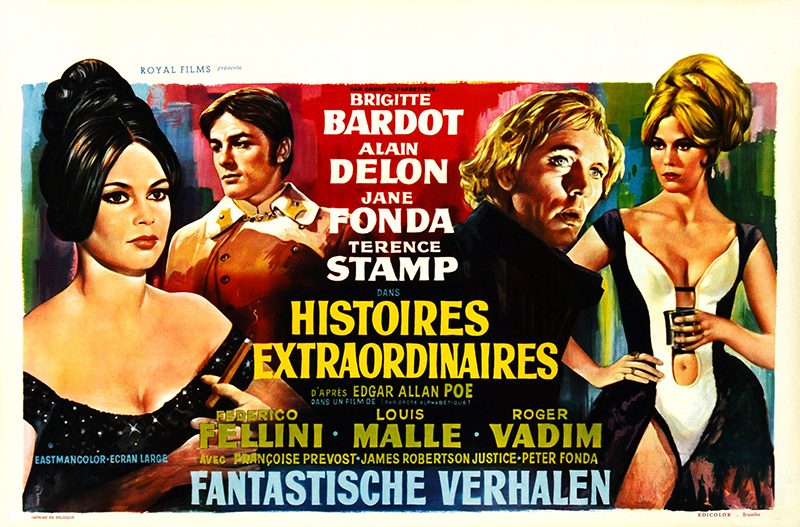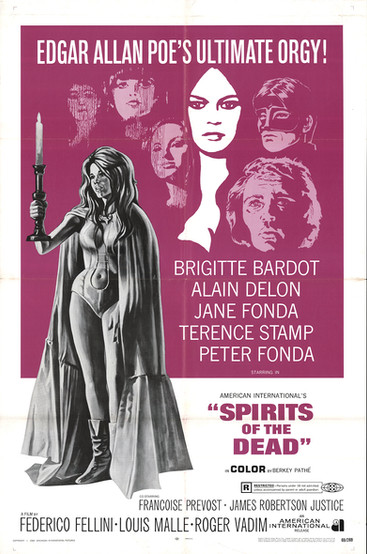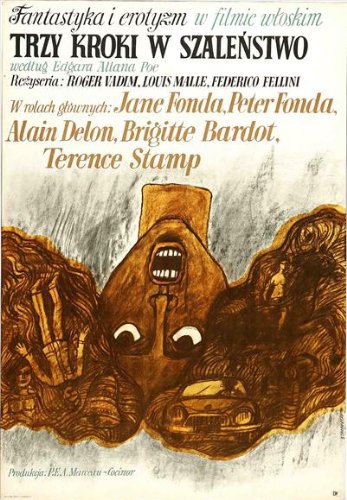Produced in 1968, "Spirits of The Dead", (alternately entitled "Tales of Mystery and Imagination" and is how it's prefaced in some versions) and based on a series of short stories by Edgar Allan Poe of the same name followed the vogue in the 1960's and 70's for the type of omnibus / portmanteau films reviewed elsewhere on this blog, such as "Kwaidan", and the format may possibly have been a way for cinemas to address the short attention span inducing effects of television, which was challenging the dominance of cinema as a medium of mass entertainment.
Unusually for the genre, horror, it attracted the attentions of notable directors such as Federico Fellini and Louis Malle though in fact both directors had contributed to similar omnibus films beforehand as writers and directors, though not in the horror genre.
It's featured on Criterion Channel's line-up of films starring Alain Delon which I'm working my way through at the moment and so I thought I'd check it out.
The film is made up of 3 short stories, the first directed by Roger Vadim and starring Jane Fonda who was fresh off her stint in Vadim's (her then husband) "Barbarella", something that is very evident in the rather kinky period costumes worn by all the characters in a tale of twisted debauchery in the "Schloss", or German chateau, of "Metzengerstein", which is also the title of the piece.
The object of Countess Frederique of Metzengerstein's (Jane Fonda) unrequited lust is her cousin "Baron Wilhelm", played by Fonda's real-life brother Peter, a detail that adds a whiff of incest to the already twisted premise.
Of course, being a Poe story, it ends horribly for the wayward Frederique.
The second story, directed by Louis Malle, is entitled "William Wilson" and stars Alain Delon and Brigitte Bardot in the tale of an Italian officer "William Wilson" (Delon) who confesses to a priest in a church confessional booth that he has committed a murder and who then recounts the events leading up to it, which forms the basis of a plot concerning Wilson's "Doppelgänger", real or imagined, and eventually leads to his death by his own hand after playing cards throughout the night and winning against the courtesan "Giuseppina" (Bardot).
The last of the three is entitled "Toby Dammit" and was directed by Federico Fellini from an adapted screenplay that takes considerable liberties with the source by projecting it forward in time and away from the period setting of the previous two segments to set it in the present day of 1968.
It stars Terence Stamp in the titular role of an actor who has been coaxed to Italy to star in a film and concerns the reality distorting effects of star adulation by fans and film people alike, something he tries to evade even though he is clearly suffering from the effects of a dissolute jet-set lifestyle. The film company gift him a new sports car to sweeten the deal and following a film awards ceremony he gets drunk and is plagued by visions of a sinister looking young girl with a ball.
Eager to escape the fans and paparazzi hot on his heels he drives off and into the city at night in his new Ferrari, by now drunk and near hysterical, and the second third of the film is comprised of the terrifying journey through the narrow Roman streets at night full of dead ends and blind alleys, until his journey is cut short by a collapse bridge.
He stops and gets out and through a swirl of mist he sees the strange girl with the ball on the opposite side of the collapsed bridge.
He decides to attempt to take the Ferrari across the yawning gap but when he reaches the other side he is decapitated by a rope strung across the road and the story ends as the strange girl picks up his severed head as the sun rises on a city that up to that point seemed shrouded in darkness, even in the daytime.
Of the three films most critics agree that Fellini's is the most personal in terms of style and in revealing Dammit's psychological state through the use of imaginative design, and I would go along with that. For example, Fellini uses all sorts of trademark visual tricks right from the get-go such as cut-outs of passengers combined with real actors waiting to board aircraft in the airport in the films' opening scenes, or odd static faces matted over the top of actors' faces to suggest Dammit's first person point of view, and miniatures and other effects that add greatly to the sense of a distorted reality as experienced by Dammit.
The first two I found to be less typically the work of the directors involved, though the costume design of "Metzengerstein" owes a lot to "Barbarella" and could be viewed as being typical of Vadim's work in terms of his depictions of women. Malle's segment was apparently beset by problems, not least of which was his difficulty in working with Delon and the fact that his first choice of actress for the part of "Giuseppina" was not Bardot, coupled with pressure from the producer to "spice-up" certain scenes with what feels like unnecessary sado-masochistic cruelty for box-office purposes, and so the end result doesn't feel as though it has Malle's fingerprint particularly.
Besides these aspects, "Toby Dammit" is the most successful in terms of conveying the mood of Poe's stories, perhaps also because Fellini chose to free it from a period setting and make it feel more relevant to audiences of the day.
It also coincidentally helped to set up the right mood to watch Guillermo del Toro's "Nightmare Alley" right afterwards which has the same surreal dream-haunting quality, seductive visuals and "chiaroscuro" lighting design of "Toby Dammit".
Foreign re-versioning of "Spirits of The Dead" included narration supplied appropriately by Vincent Price.
"Spirits of The Dead", Dir: Vadim, Malle, Fellini, 1968
Criterion Channel


















Comments